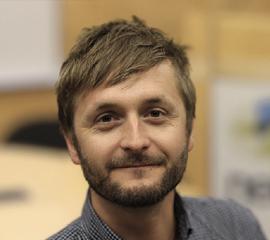ITN Impact Grant

The McGill-Western Initiative for Translational Neuroscience (ITN) brings together world-renowned scientists to work on large-scale research projects. This collaborative work will have immediate impact for patients living with brain diseases and disorders in Canada and around the world.
The ITN is supported by the Canada First Research Excellence Fund (CFREF) through McGill’s Healthy Brains, Healthy Lives and Western’s BrainsCAN initiatives.
Awarded Grants
Round 2:
Impaired tRNA Function in Amyotrophic Lateral Sclerosis (ALS)



Martin Duennwald - Sali Farhan - Thomas Durcan
Award Value: $655,000
Project Start Date: January 1, 2024
Project End Date: December 31, 2025
ALS (amyotrophic lateral sclerosis) is a fatal neurodegenerative disease with only minimal options for effective therapeutic intervention due to our limited understanding of the underpinning mechanisms. Most ALS cases have no clear family history and no known genetic causes (sporadic ALS). Transfer RNAs (tRNAs) are small molecules with many different key functions in our cells, foremost in protein biosynthesis. To function properly, tRNAs are processed by multiple steps executed by numerous enzymes. Here, we aim to decipher how impaired tRNA expression and processing contributes to ALS. Specifically, we seek to identify variants in tRNAs and tRNA processing genes that increase the risk for developing ALS and identify the mechanisms by which impaired tRNA functions affect ALS-associated neurodegeneration. Our preliminary data identify genetic variants in tRNA processing genes that are significantly more common in sporadic ALS patients compared to neurologically healthy individuals. We also have evidence that variants in tRNA genes can contribute to neurodegeneration in ALS models. We will employ state-of-the-art genetic analyses, effective yeast, and highly relevant stem cells models to identify and functionally characterize variants in tRNA and tRNA modifying genes that contribute to ALS. Our work will directly translate into a novel assessment tool to determine the risk of individuals developing ALS, e.g., as a genetic testing platform. Our research will also uncover if impaired processing of tRNAs can serve as a reliable biomarker for ALS, which will be crucial to accurately evaluate the efficacy of therapeutics in clinical trials. Furthermore, the research and analyses methods we develop for ALS can easily be transferred to other neurodegenerative diseases, such as Alzheimer’s and Parkinson’s to diagnose at-risk patients.
Translating epilepsy neuroimaging biomarkers into the operating room


Boris Bernhardt - Jonathan Lau
Award Value: $555,000
Project Start Date: March 1, 2024
Project End Date: February 28, 2026
Approximately 100,000 Canadians have pharmaco-resistant epilepsy i.e., they suffer from seizures despite adequate trials of multiple anti-seizure medications. These patients are usually considered candidates for epilepsy surgery. Depending on the patient’s type of epilepsy, current interventions include resective “open” or ablative "minimally invasive" surgery of neocortical and/or mesiotemporal regions. For types of epilepsy deemed not resectable, stimulation of subcortical regions such as the thalamus can be effective working as a "pacemaker" for abnormal brain rhythms generated in epilepsy. While each of these surgical approaches can be effective, treatment(s) must be personalized to effectively neutralize or modulate epileptic circuits, and to restore patient quality of life. Our project aims to enhance the translation of research-grade MRI biomarkers of epileptic circuits into the operating room. Based on high- and ultra-high field neuroimaging acquisitions in Montreal and London, we will (a) derive patient-specific maps of their mesiotemporal, neocortical, and subcortical anatomy, leveraging open-access tools developed at the Neuro and Western; (b) mapping patient-specific structural alterations relative to normative datasets to identify targets for open surgery and stimulation; (c) convert these maps into neuronavigation software used by surgeons at the Neuro, Western, and collaborating hospitals. Our project aims to establish a novel neuroinformatics workflow to enhance surgical target definition with seamless integration into the operating room, which will have the potential to positively impact seizure control and the well-being of Canadians suffering from pharmaco-resistant epilepsy.
Non-invasive neurostimulation guided by circuit models for suppressing epileptiform activity


Christopher Pack - Lyle Muller
Award Value: $269,153
Project Start Date: March 1, 2024
Project End Date: February 28, 2025
Just over 1 in 300 Canadians suffer from epilepsy, and in approximately one third of patients’ seizures cannot be controlled with medication. The standard clinical treatment for drug-resistant epilepsy has been resective surgery; however, even in the ideal case where lesions can be identified by structural MRI, resection does not always provide a cure. New tools are thus needed for treatment of epileptiform activity. Transcranial electrical stimulation (tES) is a non-invasive technique that delivers a weak electrical stimulus to modulate the activity of cortical circuits. tES has a well-established safety profile, and its side effects are well understood. However, because of its relatively weak effects on neural spiking activity, it has not been carefully evaluated as a potential treatment for calming neural activity during seizures. Recent work from co-PI Pack has shown that tES can successfully entrain single-neuron spiking activity (Vieira et al., PLoS Biology, 2020), and that tES’s interaction with ongoing brain activity is a key determinant of its effect (Krause et al., PLoS Biology, 2022). These results indicate that understanding ongoing brain activity may be a critical factor in delivering tES at precisely the correct time to control neural activity. Recent work from co-PI Muller has developed new computational techniques that can address the mechanism for this interaction between brain activity and tES. Muller has recently shown that ongoing brain activity is often highly organized into patterns, called traveling waves, that modulate neural excitability and perceptual sensitivity (Davis*, Muller* et al., Nature, 2020). Muller has developed large-scale spiking neural network models to understand how these activity patterns modulate neural excitability through changing the balance of excitation and inhibition (Davis, et al., Muller, Nature Communications, 2021). In this ITN Impact call, we propose to bring together the stimulation techniques developed by Pack and the computational algorithms developed by Muller to establish a new technology for suppressing epileptiform activity using tES. Both labs have developed cutting-edge techniques to study the interaction of external stimulation and endogenous brain activity; however, these techniques have never before been applied to epilepsy. Results from this research work have the potential to shape clinical practice in the treatment of epilepsy in the next few years.
Early biomarkers for development and monitoring of effective disease-modifying therapies


Mallar Chakravarty - Marco Prado
Award Value: $3,756,000
Project Start Date: April 1, 2022
Project End Date: March 31, 2025
Why do so many drug trials for neurodegenerative diseases fail? How can researchers reduce that number?
To make effective decisions about a drug’s potential success in humans, researchers need better ways to evaluate a drug’s performance before it reaches the clinical phase.
In this project, the collaborative team will develop a platform for early drug evaluation that focuses on unique imaging and cognitive biomarkers. Using a platform that works in the preclinical phase, this method will increase the likelihood that early findings will translate to the clinic. These biomarkers will also help identify patients who may benefit most from specific types of drugs.
“Our goal is to establish a novel way to consider the testing of new drugs so that we will be able to identify drugs with best potential for moving to clinical trials in humans.”
Early biomarkers to improve diagnostic workup in Parkinson’s Disease


Alain Dagher - Penny MacDonald
Funding Completed
Every day, 25 Canadians are diagnosed with Parkinson’s Disease.
Currently, there are no therapies that halt or slow the advance of Parkinson’s and diagnosis depends on costly and time-consuming clinical assessments by overburdened specialists. Getting to this diagnosis often takes each patient years.
To better understand the areas of the brain most affected by Parkinson’s, this project will use magnetic resonance imaging (MRI) to identify the disease’s biomarkers. These biomarkers will help to better diagnose Parkinson’s, reduce a patient’s wait time for a diagnosis and make it easier to measure the disease's progression.
MRI diagnostic tests could also improve health equity as underserved areas have greater access to MRI than to specialists.
“The ultimate aim is for these biomarkers to help us to uncover therapies that either slow the progression of Parkinson’s, stop it or even reverse it.”







